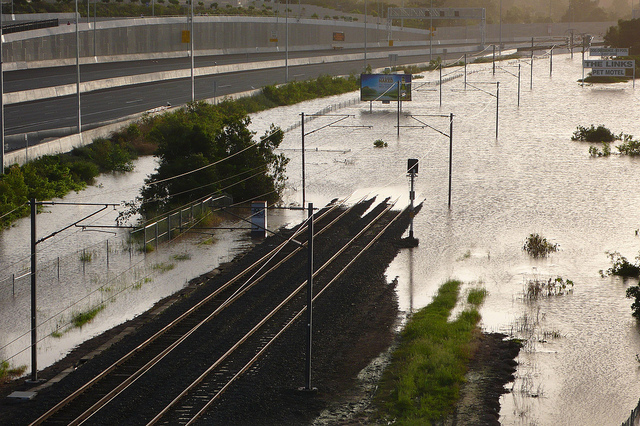Securing infrastructure
Posted By Anthony Bergin on June 7, 2013 @ 12:00
 [1]
[1]Failure to adequately invest in critical infrastructure that provides essential functions and services for our society practically guarantees we’ll see failures of critical systems when they’re put under stress by extreme weather events.
The Australian government’s Climate Commission recently released a report [2] arguing that we’re likely to see a greater spate of deadly and destructive weather events. Not being well prepared for dealing with extreme weather events is very expensive. The tab for the damage to public infrastructure across Queensland in the 2011 floods alone was between $5 and $6 billion [3] (PDF, p15).
The Climate Commission’s warning that Mother Nature is now more deadly, resulting in weather events that are more frequent and extreme, came after the Business Council of Australia’s President Tony Shepherd called for the government [4] to deliver on long term infrastructure.
We should give Infrastructure Australia an unfettered responsibility to produce a prioritised, national infrastructure plan with a focus on nationally significant projects that lift productivity.
Governments should sell infrastructure they don’t need to own, and use the funds to partner with the private sector to provide new infrastructure.
We should have a new, 10-year national infrastructure agreement that allows states to prepare long-term infrastructure plans linked to their fiscal strategies.
We think these plans should be legislated to avoid the constant chopping and changing of priorities.
Shepherd’s call is timely, not least because more extreme weather events mean that critical infrastructure will become more exposed and vulnerable. Crumbling infrastructure will imperil our safety, quality of life, and economic competitiveness. Extreme weather could damage or destroy critical infrastructure, including industrial plant, energy and transport systems and defence installations, and disrupt the continuity of essential services.
In the face of more extreme weather events, we’ll need to make adaptations in the design and location of critical infrastructure, such as power transformers and wastewater systems. In 2010, Engineers Australia found [5] that our infrastructure is plagued by ageing systems and inadequate capacity.
The Infrastructure Report Card found that little or no real overall progress has been made in the five years since Engineers Australia conducted a similar audit. In 2005 Australia’s overall result was a C+ and it was still a C+ five years later. The backlog of maintenance, repair, and needed upgrades has only continued to grow since, leaving us with aging infrastructure that’s more and more brittle. This reflect infrastructure that’s only barely adequate and in need of major changes if it’s to be fit for its current and anticipated future purposes.
If the Climate Commission’s warning that extreme weather events are becoming more frequent is right, then it’s important to try to make them less disruptive. Not investing in our critical infrastructure will only makes the next extreme weather event worse.
Making infrastructure more resilient involves making roads higher, bridges stronger, relocating rail lines, and perhaps duplicating electricity lines. But we simply can’t afford to make all of our infrastructure resilient, and it often wouldn’t be cost-effective to do so. Sometimes we’ll have to select which areas are the more important and concentrate on these. It may mean, for example, abandoning some areas where they’re regularly flooded [6] (PDF).
A tough political approach is required, because the alternatives are unaffordable. Mitigation should be a key part of Canberra’s micro-economic reform program. A now ten-year old high-level official’s report [7] (which could usefully be revisited in light of more recent data) found that ‘Additional [cost-effective] investment in natural disaster mitigation by all three levels of government is conservatively estimated to result in a rate of return of 15 per cent’. With greater population densities today, it could be higher still.
Anthony Bergin is deputy director of ASPI. Image courtesy of Flickr user martinhoward [8].
Article printed from The Strategist: https://www.aspistrategist.org.au
URL to article: https://www.aspistrategist.org.au/securing-infrastructure/
URLs in this post:
[1] Image: http://www.aspistrategist.org.au/wp-content/uploads/2013/06/5349077346_7be62917fa_z.jpg
[2] recently released a report: http://climatecommission.gov.au/report/extreme-weather/
[3] between $5 and $6 billion: http://www.chiefscientist.qld.gov.au/publications/assets/understanding-floods.pdf
[4] called for the government: http://www.bca.com.au/Content/102138.aspx
[5] Engineers Australia found: http://www.engineersaustralia.org.au/infrastructure-report-card
[6] abandoning some areas where they’re regularly flooded: https://www.aspistrategist.org.aufile://aspi-2008r2-dc/company/Groups/Programs/Operations%20&%20Capability/papers%20for%20comment/.%20http:/www.aspi.org.au/pdf/Floods_destroy_much.pdf
[7] now ten-year old high-level official’s report: http://www.em.gov.au/Documents/Natural%20Disasters%20in%20Australia%20-%20Review.pdf
[8] martinhoward: http://www.flickr.com/photos/martinhoward/5349077346/
Click here to print.